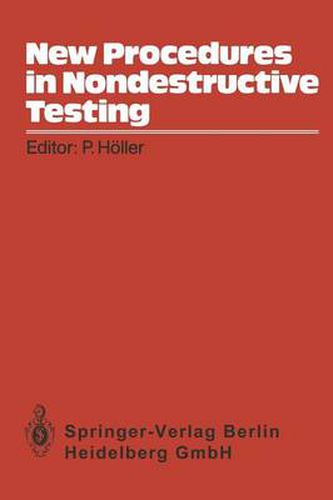Readings Newsletter
Become a Readings Member to make your shopping experience even easier.
Sign in or sign up for free!
You’re not far away from qualifying for FREE standard shipping within Australia
You’ve qualified for FREE standard shipping within Australia
The cart is loading…






This title is printed to order. This book may have been self-published. If so, we cannot guarantee the quality of the content. In the main most books will have gone through the editing process however some may not. We therefore suggest that you be aware of this before ordering this book. If in doubt check either the author or publisher’s details as we are unable to accept any returns unless they are faulty. Please contact us if you have any questions.
During recent years an increasing amount of research has been conducted to develop methods and procedures for improving inter pretation in nondestructive testing. This research covers appro priate testing procedures as well as the algorithms for interpre tation. In several cases a state has been reached which allows for implementation. The objective of the workshop was to bring together researchers and industrial users of both countries and colleagues from other countries for a thorough and critical discussion of how far we have come and where we have to go to solve the basic practical problems of interpretation in nondestructive testing and of data acquisition necessary for this purpose. Dr. Dau from EPRI stated during the last International Confer ence for Nondestructive Testing in Nuclear Industry that from the point of view of time and money spent research is the smallest part of innovation but, I would like to add in full agreement with him, the most essential. Without successful research innovation is not possible at all; but neither research and invention nor any other step in an innovation procedure can be left out. Our philosophy is to keep researchers involved until the end of the innovation. That means until a new or improved NOT-method is approved under industrial environment and implemented in industry. There can be no doubt that the further we proceed on this long road the more industry will have to be involved and assume the initiative, responsibility and the leading role.
$9.00 standard shipping within Australia
FREE standard shipping within Australia for orders over $100.00
Express & International shipping calculated at checkout
This title is printed to order. This book may have been self-published. If so, we cannot guarantee the quality of the content. In the main most books will have gone through the editing process however some may not. We therefore suggest that you be aware of this before ordering this book. If in doubt check either the author or publisher’s details as we are unable to accept any returns unless they are faulty. Please contact us if you have any questions.
During recent years an increasing amount of research has been conducted to develop methods and procedures for improving inter pretation in nondestructive testing. This research covers appro priate testing procedures as well as the algorithms for interpre tation. In several cases a state has been reached which allows for implementation. The objective of the workshop was to bring together researchers and industrial users of both countries and colleagues from other countries for a thorough and critical discussion of how far we have come and where we have to go to solve the basic practical problems of interpretation in nondestructive testing and of data acquisition necessary for this purpose. Dr. Dau from EPRI stated during the last International Confer ence for Nondestructive Testing in Nuclear Industry that from the point of view of time and money spent research is the smallest part of innovation but, I would like to add in full agreement with him, the most essential. Without successful research innovation is not possible at all; but neither research and invention nor any other step in an innovation procedure can be left out. Our philosophy is to keep researchers involved until the end of the innovation. That means until a new or improved NOT-method is approved under industrial environment and implemented in industry. There can be no doubt that the further we proceed on this long road the more industry will have to be involved and assume the initiative, responsibility and the leading role.